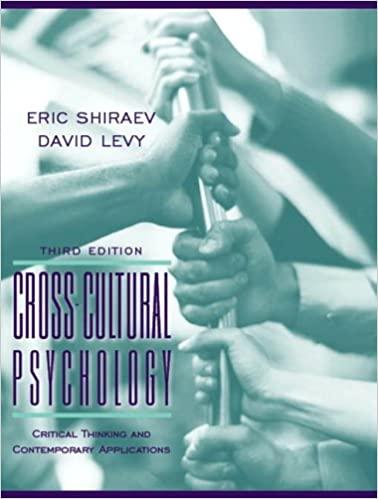Question
REFLECTION: How to read empirical journal articles Jordan, C. H., & Zanna, M. P. (1999). How to read a journal article in social psychology. In
REFLECTION:
How to read empirical journal articles
Jordan, C. H., & Zanna, M. P. (1999). How to read a journal article in social psychology. In R. F. Baumeister (Ed.), The self in social psychology (pp. 461-470). Psychology Press. *Only do outline and 3 required reflections questions (not all 6)
Recommended (No outlines or summaries needed for recommended articles): Ruben, A. (2016). How to read a scientific paper. Science.https://www.science.org/content/article/how-read-scientific-paper-rev2 https://www.science.org/content/article/how-read-scientific-paper-rev2
Ward, A. F., Duke, K., Gneezy, A., & Bos, M. W. (2017). Brain drain: The mere presence of one's own smartphone reduces available cognitive capacity. Journal of the Association for Consumer Research, 2(2), 140-154.
Read the informal "how to ask questions" document, written by Drs. Steve Lindsay and Ira Hyman - it's designed for conferences but might help you feel confident in class.
Reflections: a. Required components (CHOOSE THREE):
i. Take home message: Write what you see as the take home message of the article in one sentence. What have you learned? If you were writing a paper, what would you use this reference to cite? If you had to call grandma on the phone and talk about this paper, what would you tell her?
ii. Question: Write down at least one question you had while reading the paper that you'd like me to address in class.
iii. Surprising/interesting fact: Write down the thing you found most surprising or interesting while reading the article.
b. Additional components (choose three):
i. Sample and generalizability: Characteristics of the sample or sample(s). Who was studied? How many people were studied? Does this seem like an appropriate group of people to study for this research question? Why or why not?
ii. Measurement: How were the variables of interest manipulated or measured? Do these measurements or manipulations adequately reflect the phenomenon the researchers are interested in testing? Why or why not? What needs to change in the future?
iii. Two major strengths of this article: What are at least two things the authors did that leave you confident about the results they found? Strengths of the article have to do with the methodology the authors used, not whether they confirmed their hypotheses or not.
iv. Two weaknesses of the article: What are at least two things the authors did that leave you less confident about the results they found? Weaknesses of the article have to do with the methodology the authors used, not whether they confirmed their hypotheses or not.
v. Future of this literature (scientific relevance): What do you think a good "next step" is for this work? If you were to design a study to follow up on this work, what is something you would do next? Be detailed enough that I can reasonably imagine what this study might look like.
vi. Relevance of this work (applied relevance): What is one real-world current event or applied, socially-relevant issue or work setting that this work is relevant to, and why is it relevant? How will this article change what you will do in the future? How should this article change what others do? (Or, alternatively, should this information change what others do?)
vii. Assumptions coming in to this work: What did you know (or think you knew) about this work/field prior to reading the article, and how has your understanding of this field changed? What sets of evidence from the article shifted or challenged those assumptions? Which portions of the article were most impactful in shifting your understanding, and why were they impactful?
viii. Compare and contrast: Compare and contrast this article with a prior reading. How is this article similar to that reading? Does it use a similar method or approach? How is this article different from that reading? How do both articles leave you with a more wellrounded understanding of and appreciation for social psychology?
Step by Step Solution
There are 3 Steps involved in it
Step: 1

Get Instant Access to Expert-Tailored Solutions
See step-by-step solutions with expert insights and AI powered tools for academic success
Step: 2

Step: 3

Ace Your Homework with AI
Get the answers you need in no time with our AI-driven, step-by-step assistance
Get Started


